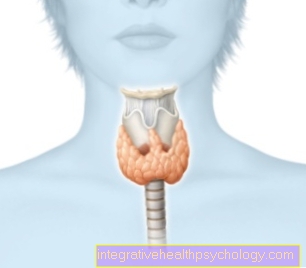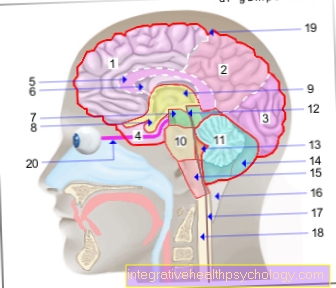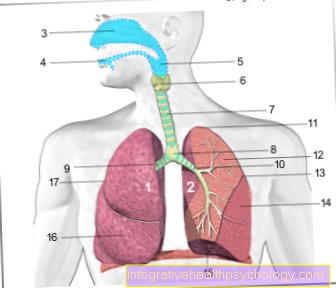coma
definition
The term "coma" comes from the Greek and means something like "deep sleep". So it is not a disease in itself, but a symptom of various diseases. The coma is the most severe form of impaired consciousness. Consciousness is the ability to (So external stimuli, other people, etc..) to perceive and interact with it.
There are generally 5 levels of consciousness:
1. Clarity of consciousness in which the environment is perceived normally and there are no impairments,
2. Drowsiness, in which there are already slight limitations in perception and the person concerned shows a certain drowsiness,
3. Somnolence is then a more pronounced drowsiness, but with which you can still wake the person affected,
4. Sopor as pronounced drowsiness, from which the person affected can hardly be woken up at all and finally
5. Coma, a state in which the person concerned can no longer be awakened by any kind of external stimuli, not even pain stimuli. The coma is the result of a serious disturbance in the function of the cerebrum and is usually a life-threatening condition.
The “artificial coma” must be distinguished from the actual coma. The term is not entirely correct in that the impairment of consciousness is deliberately brought about with medication and is completely reversible after the medication is discontinued. In the medical sense, the term coma should be reserved for uncontrolled unconsciousness. The terms "sedation" or "long-term anesthesia" are better
Read more on this topic at: Artificial coma

classification
There are several ways to divide coma into different grades or classes, usually based on medical considerations.
The most common classification of coma is in 4 grades:
1 degree: The patient shows reactions to pain in the form of targeted defensive movements (but without waking up) the pupils shrink when a light stimulus is set, also an irritation from the Balance organ triggers the corresponding eye movements (the so-called vestibulo-ocular reflex).
2 degrees: The patient only fends off pain stimuli with the help of so-called mass movements in an undirected manner, the Pupillary reflex but is still preserved, it can at most be that one Squint outwardly noticeable.
3 degrees: The defense reaction against pain is completely absent, if at all, then there are slight, untargeted movements, the vestibulo-ocular reflex is now missing and the pupillary reaction is only weakly preserved.
4 degrees: There is no longer any reaction to pain, the pupils are wide and no longer narrow when exposed to light.
The "Glasgow Coma Scale“, Which, however, also includes the less serious impaired consciousness and, above all, serves as an initial assessment on site and is intended to facilitate the decision in an emergency. This scale assigns different points in the 3 categories „eyes opening ”,“ verbal communication ”and“ motor reaction ”. The maximum number of points that can be achieved is 15, the minimum number 3, at which then a deep coma present. With a value of 8 and lower, ventilation should usually be used, as it can then be assumed that the brain function will be severely impaired.
The different types of coma
The coma, as a state of the most severe impaired consciousness (complete unconsciousness), from which the affected person can no longer be awakened even by strong pain stimuli, can be of different nature, so that - according to the cause - different types of coma can be distinguished:
- For one, a coma can result from a Brain stem damage result, especially during / after strokes (Cell death), Cerebral haemorrhage (Bleeding into the brain stem / increased intracranial pressure), Traumatic brain injuries (direct brain stem damage) or in the context of brain tumors (Increase in intracranial pressure).
-
Diabetic coma
The coma diabeticum - too Diabetic coma called - is a metabolism-related type of coma that can be triggered by a derailment of blood sugar in diabetics.
The cause of the unconsciousness is always an insulin deficiency (due to a lack of or insufficient insulin intake and an increased need for insulin), which means that sugar can no longer be absorbed from the blood into the body cells.
A distinction is made between two forms:- the ketoacidotic coma, which is triggered by an absolute insulin deficiency (typical for type 1 diabetics) and
- the hyperosmolar coma caused by a relative insulin deficiency (typical for type 2 diabetics).
The absolute insulin deficiency, caused by a lack of production in the autoimmune diseased pancreas, leads to the fact that no more sugar can be absorbed from the blood into the cells and the cells consequently try to gain energy elsewhere: by burning proteins and fats, energy is released, However, acidic metabolic products are also formed (Ketones), which gradually acidify the body.
The over-acidification can then develop into a comatose state. If the insulin deficiency is only relative, there is still enough insulin to avoid the breakdown of fats and proteins, but the available insulin is still not enough to keep the blood sugar level at normal. The high blood sugar levels lead to increased urination and an increased feeling of thirst, which can lead to a lack of water and transition into a coma. Both forms are life-threatening conditions and require immediate inpatient treatment. In 25% of the cases of a diabetic coma occurring for the first time, it is the first manifestation of diabetes mellitus, so those affected did not even know beforehand that they were suffering from diabetes.Read more on the topic: Diabetes mellitus
Causes of Coma
There are almost an infinite number of different causes of a coma, which can be found in 3 large groups let divide:
1. Diseases, the primarily that brain affect,
2. Metabolic imbalancesleading to so-called metabolic coma and
3. Poisons or. Drugs.As there are so many reasons for that unconsciousness can give, only the most important can be mentioned here.
- 1. Probably the most common cause is that stroke (Apoplexy), which can result from both a vascular occlusion and bleeding. Coma occurs primarily when the brain stem is damaged, and the condition then develops very suddenly.
2. traumatic brain injury and other skull injuries (again, brainstem damage is a particular risk).
3. Meningitis or other inflammatory diseases of the cerebrum that often occurs with fever accompanied. The coma develops gradually.
4. Brain tumors, whereby the coma is mostly not directly caused by the tumor, but comes about through the pressure increase in the brain caused by it.
5. Epileptic seizures
6. When the oxygen supply to the brain is cut off, for example when someone is strangled. - 1. Disturbances in the sugar metabolism, i.e. both hypoglycaemia (Hypoglycemia) as well as hypoglycemia (Hyperglycemia), usually as part of a Diabetes mellitus, can trigger a coma.
2. Insufficient liver function (Hepatic insufficiency) leads to the so-called hepatic coma.
3. Insufficient kidney function (Renal failure) leads to the so-called uremic coma.
4. If there is a lack of oxygen in the blood (for example, due to a disruption of the uptake of oxygen by a Pulmonary embolism or circulatory failure Heart attackstandstill or lack of fluids) the coma occurs within a few seconds - 1. alcohol
2. Intoxicants
3. medically induced coma during sedation or anesthesia
Coma from alcohol
Depending on Level of alcohol in the blood, one differentiates between different stages of alcohol intoxication.
From an alcohol concentration of 4.0 per mille it can be life threatening alcoholic coma come, a failure of the function of all vital organs (multi-organ failure) can follow and the body's reflexes and breathing are significantly reduced or even fail completely. Due to the acute danger to life, this condition must be treated as an in-patient, intensive care unit in the hospital as soon as possible.
The cause of the alcoholic coma lies in the toxicity of alcohol:the liver, as an organ that breaks down or eliminates alcohol, is fully utilized when a certain amount of alcohol is consumed. In addition, the breakdown of alcohol always produces toxic by-products (acetaldehyde) that accumulate in the blood together with the ethanol. These two cell poisons mainly damage liver and nerve cells, but they also have a highly damaging effect on all other organ systems. The nerve cell damage or paralysis and the death of the nerve cells in the area of the brain stem represent the cause of loss of consciousness up to coma, of reflex failures and respiratory depression.
Diagnosis of coma

coma Correct and above all quick diagnosis of a coma is of crucial importance. First of all, the unconscious person is spoken to and you try to wake him up and test his reflexes. For example using the Glasgow Coma Scale (see above) a first, more precise assessment of its condition can then be given. It is also important to ask those present who may have seen a possible cause of the coma (for example at Poisoning or accidents) or because they know the patient's history, for example they can tell the doctor whether the person concerned has previous illnesses such as diabetes mellitus. Then the doctor checks the vital signs (Pulse, blood pressure and breathing).
If an EKG device is available, it should be connected in order to provide more precise information about the heart function. Of course, the First aid to be guaranteed. After the first aid measures on site, depending on what triggered the coma, further examinations can be carried out, for example an examination of blood or cerebral fluid (CSF diagnostics), a roentgen, a Ultrasonic, one Computed Tomography (CT), a magnetic resonance imaging (MRI), an electroencephalogram (EEG) and many others.forecast
The prognosis of a Coma patients depends above all on the underlying disease and on medical care and therefore cannot be generalized.
A coma can only last for a very short time. If that brain If there is not enough oxygen for a short period of time, an affected person usually becomes unconscious and falls over, which often improves the blood flow to the brain to such an extent that after a few seconds he spontaneously recovers and regains full consciousness. This is known as "syncope". The same applies to the epileptic seizures.
The comatose state can, however, last for several days or even weeks. Then the condition of the person concerned has to improve or brain death occurs. Some of the patients slip into it Vegetative state (apallic syndrome) or regains a minimal state of consciousness, some also regain their full consciousness, but remain (almost) completely paralyzed (Locked-in syndrome).
Coma and brain death
Of the brain death is a fixed definition of death introduced in 1968, with which the irrevocable extinction of all brain functions by an extended Nerve cell death is meant, whereby the cardiovascular function is still maintained by controlled mechanical ventilation.
It is considered the most certain sign of death, so that the so-called brain death diagnostics can be useful for an unequivocal assessment of the death of a person.
Also in the context of Organ donation and Transplants The determination of brain death or the diagnosis of brain death is an essential prerequisite for the further procedure and the subsequent organ removal. Brain death is determined by two doctors (neurologists) who act independently of each other and who are not involved in a possibly planned one Transplantation / organ removal participate.However, it can only be determined under intensive medical conditions by maintaining the blood circulation and oxygen uptake of the body organs through mechanical ventilation, hormone replacement and circulatory therapy. Clinical signs of brain death are the lack of spontaneous breathing, the lack of brain stem reflexes (such as the Cough reflex, Pupillary reflex (rigid to light), Lid closing reflex), the loss of consciousness (coma) and light-rigid pupils. Additional machine information can be a zero line in the brain wave recordings (EEG) as well as no signs of blood flow in the brain ultrasound or the cerebral vessels (angiography).
Summary
Under coma one understands the most severe form of a disturbance of consciousness in which the patient can no longer be awakened even by repeated use of pain stimuli. It is caused by a pronounced disorder of the cerebrum, which can result from a wide variety of underlying diseases. Often a coma develops in one, for example stroke, a sugar metabolism disorder, lack of oxygen, liver - or Renal failure or poisoning.






























